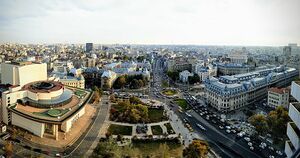Difference between revisions of "Bucharest"
(Added: wikiquote, map, coordinates.) |
(unstub) |
||
| Line 1: | Line 1: | ||
{{place | {{place | ||
|wikipedia=https://en.wikipedia.org/wiki/Bucharest | |wikipedia=https://en.wikipedia.org/wiki/Bucharest | ||
| − | |image= | + | |image=Bucharest city center.jpg |
|image_caption= | |image_caption= | ||
|constitutes=city | |constitutes=city | ||
| Line 8: | Line 8: | ||
|map=600px-Bucharest_-_Spitalul_Clinic_Coltea_-_pano_01-equalized.jpg | |map=600px-Bucharest_-_Spitalul_Clinic_Coltea_-_pano_01-equalized.jpg | ||
|coordinates=44.43250, 26.10389 | |coordinates=44.43250, 26.10389 | ||
| + | |description=Economic and political capital of [[Romania]] | ||
}} | }} | ||
| − | '''Bucharest''' has hosted a meeting of [[Le Cercle]], according to a story in the ''[[Independent]]'' of June 29, 1997. | + | '''Bucharest''' is the capital and largest city of [[Romania]], as well as its cultural, industrial, and financial centre. |
| + | |||
| + | According to the [[Demographic history of Romania|2011 census]], 1,883,425 inhabitants live within the city limits. Adding the satellite towns around the [[Largest urban areas of the European Union|urban area]], the proposed [[Bucharest metropolitan area|metropolitan area]] of Bucharest would have a population of 2.27 million people. Bucharest is the fourth [[List of cities in the European Union by population within city limits|largest city]] in the [[European Union]] by population within city limits, after [[Berlin]], [[Madrid]], and [[Rome]]. | ||
| + | |||
| + | '''Bucharest''' has hosted a meeting of [[Le Cercle]], according to a story in the ''[[Independent]]'' of June 29, 1997. | ||
| + | |||
| + | ==Economy== | ||
| + | Bucharest is the centre of the Romanian economy and industry, accounting for around 24% (2017) of the country's GDP and about one-quarter of its industrial production, while being inhabited by 9% of the country's population.<ref>https://web.archive.org/web/20131101013924/http://www.erionet.org/JIM%2BRomania.htm </ref> Almost one-third of national taxes is paid by Bucharest's citizens and companies. The living standard in the Bucharest-Ilfov region was 145% of the EU average in 2017, according to GDP per capita at the purchasing power parity standard (adjusted to the national price level). | ||
| + | |||
| + | Bucharest's economy is centred on industry and [[Service Sector|services]], with services particularly growing in importance in the last 10 years. The headquarters of 186,000 firms, including nearly all large Romanian companies, are located in Bucharest. An important source of growth since 2000 has been the city's rapidly expanding property and construction sector. Bucharest is also Romania's largest centre for information technology and communications and is home to several software companies operating offshore delivery centres. Romania's largest stock exchange, the [[Bucharest Stock Exchange]], which was merged in December 2005 with the Bucharest-based electronic stock exchange [[Rasdaq]], plays a major role in the city's economy. | ||
| + | |||
{{SMWDocs}} | {{SMWDocs}} | ||
==References== | ==References== | ||
{{reflist}} | {{reflist}} | ||
| − | |||
Latest revision as of 02:04, 13 April 2021
(City) | |
|---|---|
 | |
| 250px | |
| Subpage(s) | •Bucharest/Mayor |
| Economic and political capital of Romania | |
Bucharest is the capital and largest city of Romania, as well as its cultural, industrial, and financial centre.
According to the 2011 census, 1,883,425 inhabitants live within the city limits. Adding the satellite towns around the urban area, the proposed metropolitan area of Bucharest would have a population of 2.27 million people. Bucharest is the fourth largest city in the European Union by population within city limits, after Berlin, Madrid, and Rome.
Bucharest has hosted a meeting of Le Cercle, according to a story in the Independent of June 29, 1997.
Economy
Bucharest is the centre of the Romanian economy and industry, accounting for around 24% (2017) of the country's GDP and about one-quarter of its industrial production, while being inhabited by 9% of the country's population.[1] Almost one-third of national taxes is paid by Bucharest's citizens and companies. The living standard in the Bucharest-Ilfov region was 145% of the EU average in 2017, according to GDP per capita at the purchasing power parity standard (adjusted to the national price level).
Bucharest's economy is centred on industry and services, with services particularly growing in importance in the last 10 years. The headquarters of 186,000 firms, including nearly all large Romanian companies, are located in Bucharest. An important source of growth since 2000 has been the city's rapidly expanding property and construction sector. Bucharest is also Romania's largest centre for information technology and communications and is home to several software companies operating offshore delivery centres. Romania's largest stock exchange, the Bucharest Stock Exchange, which was merged in December 2005 with the Bucharest-based electronic stock exchange Rasdaq, plays a major role in the city's economy.
Groups Headquartered Here
| Group | Start | Description |
|---|---|---|
| Bucharest Polytechnic Institute | 1818 | The largest technical university in Romania |
| National Bank of Romania | 1880 | |
| Romania | European country. Location of a deep state attempted coup involving Dick Cheney, NATO and a VIPedophile ring. | |
| University of Bucharest | 1864 | University of national Romanian importance. |